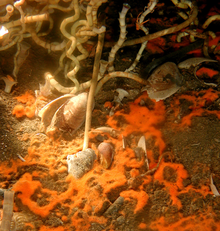Lamellibrachia luymesi
| Lamellibrachia luymesi | |
|---|---|

| |
| Scientific classification | |
| Domain: | Eukaryota |
| Kingdom: | Animalia |
| Phylum: | Annelida |
| Clade: | Pleistoannelida |
| Clade: | Sedentaria |
| Order: | Sabellida |
| Family: | Siboglinidae |
| Genus: | Lamellibrachia |
| Species: | L. luymesi
|
| Binomial name | |
| Lamellibrachia luymesi van der Land & Nørrevang, 1975
| |
Lamellibrachia luymesi is a species of tube worms in the family Siboglinidae. It lives at deep-sea cold seeps where hydrocarbons (oil and methane) are leaking out of the seafloor. It is entirely reliant on internal, sulfide-oxidizing bacterial symbionts for its nutrition. These are located in a centrally located "trophosome".


Lamellibrachia luymesi provides the bacteria with hydrogen sulfide and oxygen by taking them up from the environment and binding them to a specialized hemoglobin molecule. Unlike the tube worms Riftia pachyptila that live at hydrothermal vents, L. luymesi uses a posterior extension of its body called the root to take up hydrogen sulfide from the seep sediments. L. luymesi may also help fuel the generation of sulfide by excreting sulfate through their roots into the sediments below the aggregations.[2]
To support the carbon fixation they need for maintenance and growth, L. luymesi needs to extract sulfide, oxygen, and inorganic carbon from its environment and supply them to its symbionts in the trophosome via the vascular system. It also needs to ensure that no build up of the sulfate and hydrogen ion waste products occurs, which would inhibit the bacterial activity. Laboratory experiments have shown that although some of the waste products diffuse into the water column, about 85% of the sulfate produced and about 67% of the hydrogen ions are eliminated across the roots.[3]
The most well-known seeps where L. luymesi lives are in the northern Gulf of Mexico from 500 to 800 m depth. This tube worm can reach lengths over 3 m (10 ft), and grows very slowly, and its longevity is over 250 years. It forms biogenic habitat by creating large aggregations of hundreds to thousands of individuals. Hydrogen sulfide can be lethal for many marine organisms, and the tubeworms help minimise the sulfide levels and maintain a stable habitat. Living in these aggregations are over 100 different species of animals, including brachiopods, molluscs, sponges, arthropoda, and chordates, many of which are found only at these seeps.[4]
Reproduction[edit]
L. luymesi, is a dioecious vestimentiferan[5][6].Though detailed observations of L. luymesi's mating behaviors are lacking, the anatomical structures suggest adaptations for sexual reproduction[7]. The female vestimentiferans' reproductive system opens anteriorly, amid the vestimental wings[5]. Then meandering oviducts course through the trunk enveloped by trophosome tissue[5]. In L. luymesi, the gonad occupies the anterior two-thirds of the trunk, featuring paired gonocoels housing ovaries running parallel and dorsal to the oviducts[4]. These gonocoels posteriorly bend, transitioning into paired oviducts[7].
Research has shown that the sperm bundles of both Riftia pachyptila and L. luymesi are analogous[8]. It has been found that fertilization in R. pachyptila is generally internal[9].
References[edit]
This article incorporates a CC-BY-2.5 from references.[1][2]
- ^ a b Boetius A. (2005). "Microfauna–Macrofauna Interaction in the Seafloor: Lessons from the Tubeworm". PLoS Biology 3(3): e102. doi:10.1371/journal.pbio.0030102
- ^ a b c Cordes E. E., Arthur M. A., Shea K., Arvidson R. S. & Fisher C. R. (2005). "Modeling the Mutualistic Interactions between Tubeworms and Microbial Consortia". PLoS Biology 3(3): e77. doi:10.1371/journal.pbio.0030077
- ^ Sharmishtha Dattagupta, Lara L. Miles, Matthew S. Barnabei, Charles R. Fisher (2006). "The hydrocarbon seep tubeworm Lamellibrachia luymesi primarily eliminates sulfate and hydrogen ions across its roots to conserve energy and ensure sulfide supply". Journal of Experimental Biology. 209 (19): 3795–3805. doi:10.1242/jeb.02413. PMID 16985196.
{{cite journal}}: CS1 maint: multiple names: authors list (link) - ^ a b Alexia Barlikas, Asa Dewan, Mofolusho Sodeke (2011). "Lamellibrachia luymesi". Animal Diversity Web. Retrieved 28 June 2020.
{{cite web}}: CS1 maint: multiple names: authors list (link) - ^ a b c Van Der Land, Jacob; Nørrevang, Arne (1977). Structure and Relationships of Lamellibrachia (Annelida, Vestimentifera) (PDF). Munksgaard. pp. 8–10, 56–64. ISBN 8773040886.
{{cite book}}: CS1 maint: date and year (link) - ^ Tyler, P. A.; Young, C. M. (April 1999). "Reproduction and dispersal at vents and cold seeps". Journal of the Marine Biological Association of the United Kingdom. 79 (2): 193–208. doi:10.1017/S0025315499000235. ISSN 1469-7769 – via Cambridge University Press.
- ^ a b Hilário, Ana; Young, Craig M.; Tyler, Paul A. (5 October 2004). "Sperm Storage, Internal Fertilization, and Embryonic Dispersal in Vent and Seep Tubeworms (Polychaeta: Siboglinidae: Vestimentifera)". The Biological Bulletin. 208 (1): 20–28. doi:10.2307/3593097. ISSN 0006-3185 – via The University of Chicago Press Journals.
- ^ Marotta, Roberto; Melone, Giulio; Bright, Monika; Ferraguti, Marco (8 June 2005). "Spermatozoa and Sperm Aggregates in the Vestimentiferan Lamellibrachia luymesi Compared With Those of Riftia pachyptila (Polychaeta: Siboglinidae: Vestimentifera)". The Biological Bulletin. 209 (3): 215–226. doi:10.2307/3593111. ISSN 0006-3185 – via The University of Chicago Press Journals.
- ^ Gardiner, Stephen L.; Jones, Meredith L. (1985). "Ultrastructure of Spermiogenesis in the Vestimentiferan Tube Worm Riftia pachyptila (Pogonophora: Obturata)". Transactions of the American Microscopical Society. 104 (1): 19–44. doi:10.2307/3226354. ISSN 0003-0023.
